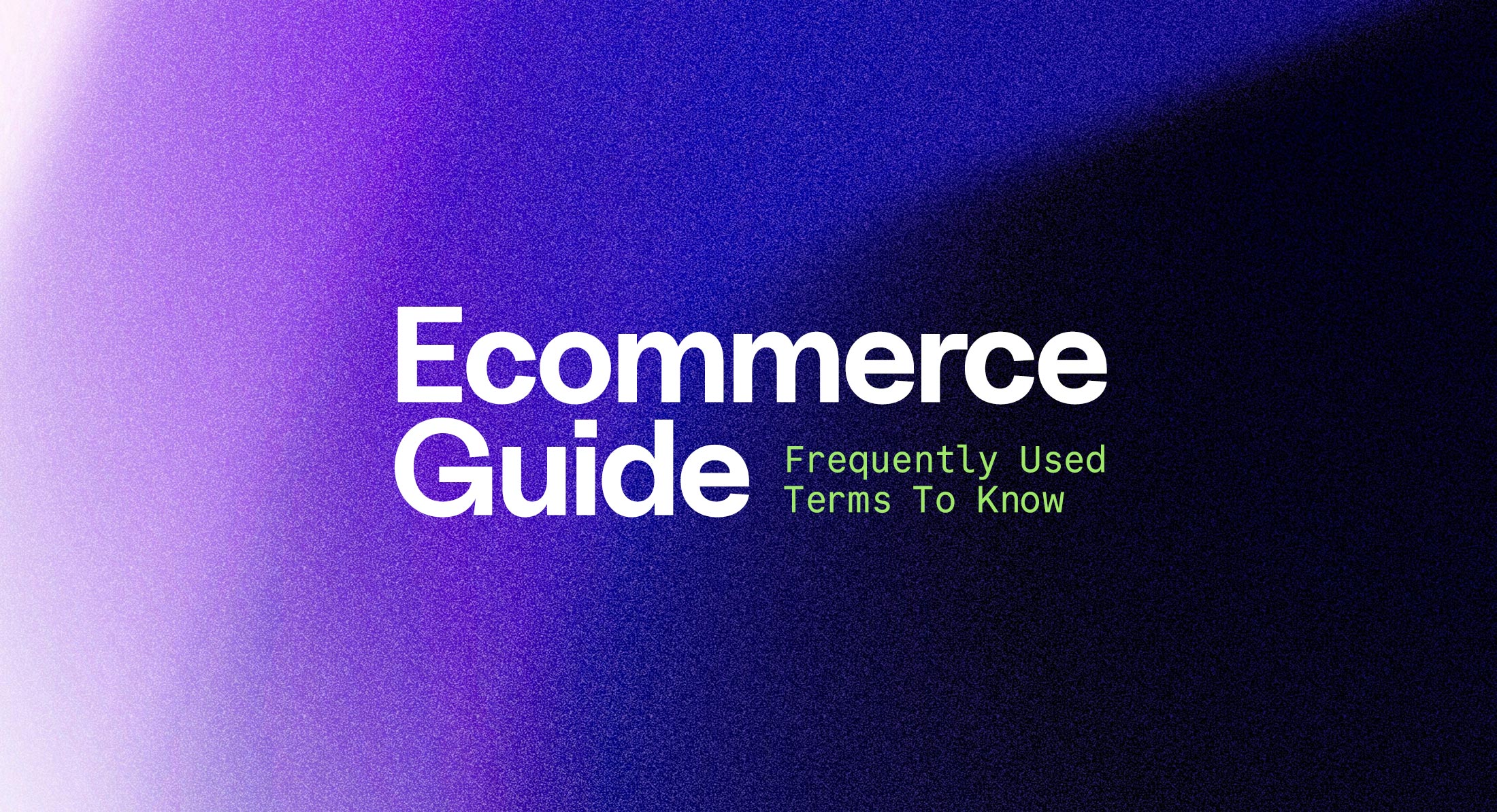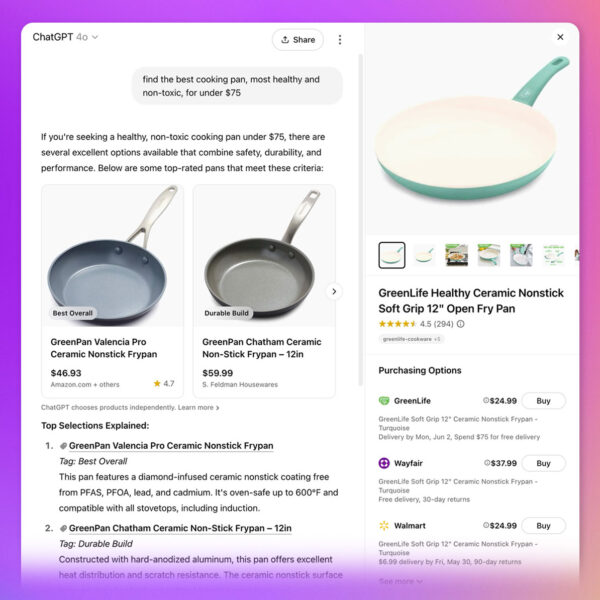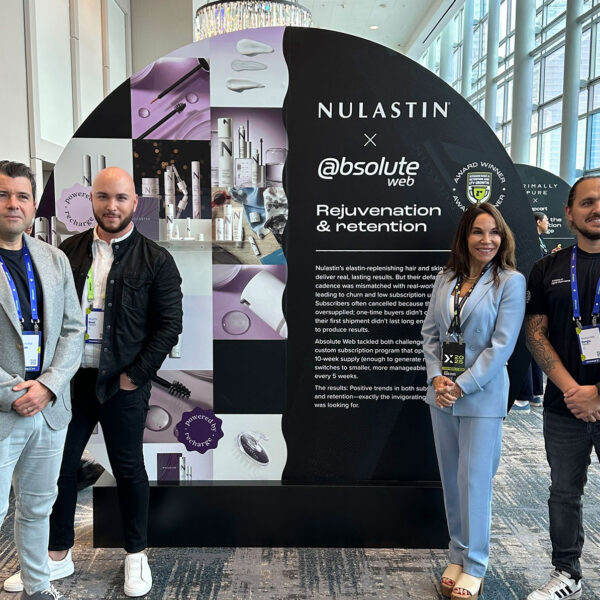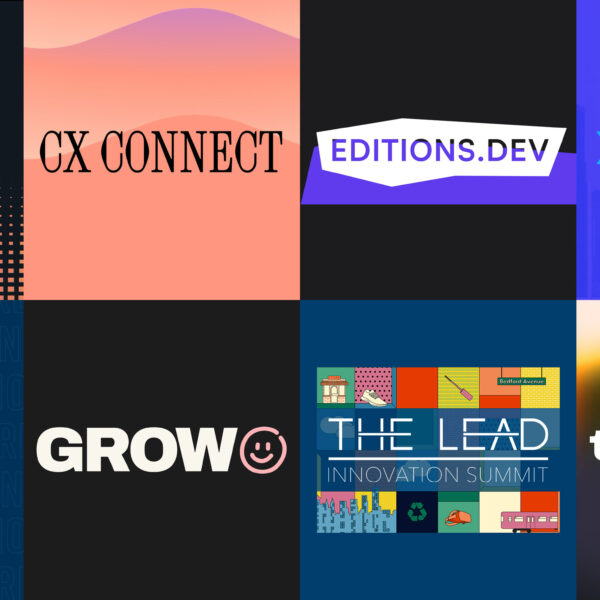
Ecommerce Guide: Frequently Used Terms to Know
The ecommerce industry often introduces new or frequently used terms throughout day-to-day conversations and across various industries. When you’re running or managing a successful ecommerce website, it’s important to know frequently used terms to help enhance and optimize your ecommerce operations and stay updated with the latest trends.
If you’re not familiar with terms like Git, A/B Testing, SaaS or B2B, we’re here to help and catch you up to speed with this comprehensive ecommerce guide and glossary.
At the very basic level, ecommerce, also known as electronic commerce, is known as any type of business or sales transaction that happens over the internet. As the ecommerce industry continues to grow exponentially at 23 percent every year, there are several key terms to familiarize yourself with.
Whether you need clarification or just a simple refresher session, we’re here to break it all down for you.
We’ve put together an informative glossary guide to help you stay on top of current terminology you might come across. The following glossary is a list of just a few of the many terms that every ecommerce expert and business owner needs to know.
*We will be updating this guide periodically, so check back for more terms.
Ecommerce Glossary
A
Authorization: This is required to verify whether a credit card has sufficient funds for the transaction to be able to successfully go through. The electronic authorization request by a merchant may include an authorization approval or decline option. Authorization is required for every sale and transaction.
Authorized Reseller: A reseller that is permitted and authorized to sell digital products directly to consumers on behalf of a brand or company.
Abandonment Rate: This refers to the percentage or number of visitors or potential customers that leave a particular website without making or following through with a purchase. For instance, a consumer could have put a few items in an online shopping cart but decided to abandon the transaction.
A/B Testing: This is primarily used as a method by companies to determine the effectiveness of one page versus another for promotional and marketing purposes.
Affiliate Marketing: An advertising and digital marketing tactic used to generate online revenue for promoting a brand’s products. For example, an influencer or loyal customer might work as an affiliate to provide recommendations and promote an online product. If that particular product link is clicked or purchased based on recommendations, the publisher of the marketing post will receive a commission from the sales they make.
Artificial Intelligence: A branch of computer science in which machines are able to intelligently work and react like humans. Also known as AI, this involves advancements in machine learning and the building of smart machines that are able to perform or outperform the tasks of humans.
Attachment: A file of any format that is usually “attached” or included in an email message for opening or downloading.
Augmented Reality: Technology that brings computer-generated and digital elements into the real world, by enhancing it with an interactive experience based on virtual information and data.
Autoresponder: An automated message that is sent to a subscriber.
Average Time on Site: The average duration of time a user spends viewing your site. This is also known as Session Duration in Google Analytics.
B
Banner Exchange: A networking exchange where websites will display and promote certain types of banner ads on their site in exchange for receiving credit for a similar exchange of ads on another website or business page.
B2B: This is an acronym for “Business-to-Business,” which refers to the type of ecommerce exchange when a business sells a good or service between business rather than consumers.
B2C: Known as Business-to-consumer, this retail process happens when businesses sell products or services directly to the consumer.
BigCommerce: A privately-held ecommerce company with a SaaS ecommerce platform that helps businesses build a successful shop and scale seamlessly with technology they can trust. Features allow businesses to easily sell products, manage orders, process payments, and use many of its various features such as search engine optimization, web hosting, and more.
Bounce Rate: This happens when a certain number or percentage of visitors click on a web page and end up exiting (bouncing) without clicking or visiting other pages on the website.
Brick and Mortar Shop: A business or retail operation that has at least one physical location. Many customers still prefer walking into a physical, brick and mortar shop while alternatively using online shopping to identify products before making an in-store purchase.
C
Cache: This involves the process of storing several copies of files in a temporary storage location known as a cache for easy access.
Call-To-Action: A distinctive, clear marketing message that aims to persuade and encourage a site visitor or consumer to take the desired action whether that is purchasing a product, or taking advantage of a product discount.
Card Present: These transactions are common in brick and mortar stores. Typically, during checkout, you will be asked to physically swipe your credit or debit card to go through with the transaction in-person. The sale is then considered to be, “card present.”
Card-Not-Present: These are transactions that can be processed without the cardholder present at the time of purchase. Typically, transaction processing fees are arguably higher than for Card Present transactions.
Cart Abandonment Rate: This term is associated with a virtual shopping cart and the rate at which a shopping cart is abandoned. A cart being abandoned means that a purchase or sale did not occur. This could be due to a variety of reasons such as complicated, non-user friendly booking, lack of streamlined web design, or a customer changing his/her mind about a product purchase.
Category Page: A specific page on a site to help users easily navigate and find items, or terms they are searching for. An example of a category page on an ecommerce site selling sunglasses could be titled “Prescription Glasses” or “Women’s Sunglasses.”
Chatbot: An automated computer program or “bot,” that is designed to communicate and answer any questions that users may have. Chatbots are typically used in tandem or in the absence of a customer service team to alleviate a high level of inquiries.
Churn Rate: The percentage of customers or subscribers that decide to halt business with a particular company. Understanding Churn Rate can help companies better prepare or figure out new ways to retain customers.
Click-to-Open Rate: Also known as CTOR, this term compares the number or rate of people who initially opened an email to the number of people who clicked on a link in that email. The purpose of this is to distinguish and decipher the quality of email content and whether it is able to get customers to click on email links and engage with it. The CTOR can be measured by the following mathematical formula: # of Clicks ÷ # of Opens × 100 (to get a percentage) = CTOR.
C2C: Known as Consumer-to-Consumer ecommerce, this process involves consumers trading various services and products with other consumers online.
Cloud computing: The process of hosting, storing, and delivering on-demand information and other virtual resources on the Internet using a remote network of servers, instead of on your computer’s hard drive.
Cloud Hosting: This type of web hosting is different from traditional web hosting and provides customers multiple connected servers that make up a cloud. Users can access a cluster of resources from multiple servers instead of retrieving data from a single server. Everything is interconnected in the cloud and more resources may be added to the cloud. Sometimes cloud hosting can also be referred to as “server on-demand hosting” or “cluster server hosting.”
Comma Separated Value: Also known as CSV, this refers to a text-only file that saves data in a simple table format that can be imported into almost any program.
Content Management System: Referred to as CMS, this term is a platform that allows for the publishing, monitoring, and various other editing or content modifications to the website. A few popular CMS platforms include WordPress, Drupal, Squarespace.
Conversion Funnel: An ecommerce phrase that is commonly used to represent a consumer or potential visitor’s journey on a company’s website. The goal is to create actionable plans to encourage visitors to either sign up for a service, subscribe, or purchase a product.
Cookies: Data from a website that is stored in the user’s browser. A user’s information–everything from passwords to location data is stored in these cookies. Websites are required to have cookie disclaimers, allowing users to opt-in or opt-out.
Conversion Rate: The equivalent of the percentage or number of visitors on a website that converts into customers.
Conversion Rate Optimization: The process involved with optimizing a website or landing page based on prior website visitor behavior in order to achieve better conversions and facilitate better user experience.
CSS: A programming language known as Cascading Style Sheets written in a markup language like HTML that helps designate certain fonts, colors, or styles to appear or be modified on a web page.
Customer Lifetime Value: Also known as CLV, this term represents a customer’s lifetime value and measures the amount of revenue or value the customer brings to a business. To calculate CLV, a business should be able to factor in and analyze the following aspects of customer behavior: Average order value, customer purchase frequency, customer lifespan and retainer, including profit margin.
Customer Relationship Management: Also known as CRM, this is referred to as an approach that helps businesses improve customer relationships while nurturing new customer relationships as well.
Customer Returns: These refer to returned items from a customer, to a retailer. This could be due in part to a defective item, a customer’s change in preference, or other reasons.
Cyber Monday: Sales and promotions that are typically launched the Monday after Black Friday.
D
Dashboard: In ecommerce, a dashboard is essentially a hub that tracks performance data and gives you an “at a glance” snapshot view of your online store. This includes traffic, revenue and sales, traffic sources, and more.
Data Migration: Referred to as the process of successfully migrating, or transferring a set of data to another improved location for website infrastructure efficiency and website optimization purposes.
Digital Commerce: The digital infrastructure that comprises ecommerce and involves communication and exchange via mobile search engines, mobile apps, social platforms, and anything else related to online or digital.
Digital Wallet: A system that securely stores user payment information and passwords digitally. They can be conveniently used in conjunction with mobile payment systems or to retrieve other pertinent information.
Directory: A systematic search platform that arranges web pages into organized categories and subcategories.
Discount Code: A unique code that an online shopper can apply during the online checkout process to receive a certain discount or other offer. They can also be referred to as “coupon codes.”
Distributed Denial-of-Service (DDoS): This refers to a denial or an attempt to make an online service unavailable by inundating it with traffic from other sources to disrupt the flow of service.
Domain Name: This refers to a unique name that establishes a particular organization or entity on the Internet. This is done through the guidelines provided by the Domain Name System (DNS), which provides addresses to web servers and pages.
Dropshipping: This is where the manufacturer ships items directly to the customer in generic packaging.
Duplicate Content: Content that is duplicated multiple times or seen on different online websites or places on the Internet.
D2C: Also known as direct-to-consumer, this refers to the process in which a company cuts the middle process and instead, sells directly to the consumer.
E
eBay: One of the most successful early ecommerce companies based in San Jose, California, which gives power to C2C and B2C ecommerce sales through its website. The site features sellers and buyers and allows for the selling of new or used products on the platform in an auction-like online retail setting.
Ecommerce: Known as electronic or internet commerce, this refers to the buying or selling of goods and products over the internet.
Ecommerce Merchandising: A marketing concept that involves strategic arranging and the displaying of products, offers, or services on website pages to increase sales and visibility through personalization and other techniques.
Email Marketing: This is a component of digital marketing and is associated with communicating through an email subscription to develop and nurture relationships with consumers and promote items or special deals.
Encryption: The process of scrambling or rearranging a message to ensure data security and secrecy. There are two main types of encryption methods: Private Key and Public Key Encryption.
Enterprise Resource Planning: Also known as ERP, this is a backend business management software that helps small and large-scaled businesses manage their data utilizing a system of automated integrated applications. ERPs are used to handle various backend items such as product information, inventory, shipping, payments processing, and more.
Etailing: Also known as “electronic retailing,” this term refers to the sale of retail goods on the internet. Consumers can browse products virtually and complete their purchase online through a virtual shopping cart system.
Event-triggered email: Automated email messages that are sent to a customer or company subscribers in relation to an annual, recurring, or particular event such as a registration date or birthday date.
Evergreen content: Online or digital content that stays relevant enough to be continually promoted or featured regardless of timeliness.
Expedited Shipping: A form of shipping that is given a priority and delivered in a much shorter length of time than the standard delivery time frame. Customers will be charged an extra fee for choosing expedited shipping.
F
Favicon: Also known as a shortcut icon, this small feature is a 16 x 16 icon logo that appears at the top of the web browser and serves as a branded icon to represent and convey a website’s function or primary brand logo.
F-Pattern: This refers to the process or way in which consumers digest online content. Usually, the pattern follows a left to right motion, followed by users shifting their attention to downward content.
Firewall: A network security system that is designed to control access to or from a specific network, and establishes a barrier between trusted and untrusted networks and whether to move forward.
Flash Sale: A limited-time discount or offer promoted by a retailer.
Front End: This is known as the website user interface, or the “front end” of what a user sees and interacts with when they first visit a website.
Fulfillment: The process involved with receiving, packaging, and shipping various orders through an ecommerce site.
G
Gated Content: Content that is guarded or put under an embargo until a user fills out a form or provides further information in order to access, download, or read the rest of the content.
Git: This is the most commonly used version control system and is becoming the standard for version control, according to Microsoft Word. There’s a booming Git user community that helps train developers and get help when you need it.
Google Analytics: A web analytics service by Google that analyzes and examines your website traffic with detailed reports. This free service also gives you the tools to better understand your site performance and ranking.
Google Trends: A marketing tool that allows the user to compare the frequency of a term or keyword on Google search results.
H
Hamburger Navigation: A navigation tab on the top or left-hand corner of a website that appears as 3 dots or 3 horizontal lines (reminiscent of a hamburger). When clicked, the button will create a dropdown menu from a website to help users easily navigate to other resources on the page.
HTML: Text-based language or a standardized system for tagging text files that have been used to build web pages.
HTTP: Also known as HyperText Transfer Protocol. You’ll often see it written as http://. The HTTP is the standard protocol used by the World Wide Web and it essentially shows what messages are transmitted and what browsers should do in response to commands.
Hypertext: This refers to the text that is hyperlinked. Once a user clicks on the link, another web page with content will appear. The link can either be opened in another tab, or programmed to have the user stay on the current website.
I
Impressions: The number of times in which ad, images, content, or particular items are displayed to a user to produce and deliver results.
Inbound Links: Also referred to as backlinks, these links are found on other web pages and help direct customers to your website.
Indexing: Analyzing and storing specific data or information from websites. The stored data will then be sorted into a specific index to answer search queries.
Infinite Scroll: This refers to content being loaded and showcased continuously as a web visitor scrolls down a web page.
Influencer Marketing: A social media marketing tool and relationship among certain brands and Influencers to drive brand messaging and target new or continued customers. The goal is to have an Influencer endorse or promote products on behalf of a brand or company and spread awareness about the brand itself.
Inventory: An organized amount of items or products that are intended to be sold to customers.
In-Store Search: A search function on your website that helps shoppers easily navigate and enter keywords to find specific products on your online site.
Internet of Things: A series of interconnected devices that work in unison to connect and exchange various sets of data and information.
Internet Service Provider: Also known as ISP, this refers to a company providing individuals and companies access to the Internet and other services such as virtual hosting.
IP Address: Internet Protocol Address, or a specific unique number that represents a computer in a network setting. All computers have a unique IP address and the format is listed as the following: 194.403.387.6
J
Javascript: A type of scripting language that is used to make web pages both interactive and dynamic for the user.
JPEG: Also known as Joint Photographic Experts Group, this term refers to a type of image file that can be saved and used on the Internet. JPEG files are compressed and go by the extension, “.jpg”.
K
Keywords: These are SEO terms, words, or phrases that are added to a website for the purpose of helping optimize and improve search engine rankings.
Keyword Stuffing: A term used in SEO to refer to overloading your webpage with too many SEO keywords to increase your site’s ranking, and as a result, affecting the readability of the content.
KPI: This is known as Key Performance Indicator or a type of performance measurement tool that is used to evaluate the success of a particular campaign, department, or organization in regards to strategic goals.
L
Landing page: The page visitors or customers will “land on” either through means of paid traffic or generic search traffic, referrals, or hyperlinks.
Link Building: A marketing strategy aimed at improving the SEO rank or positioning of a website. This involves focusing on backlinks and reaching out to other sites to see if it can be linked by third parties, and vice versa.
Listing Fee: A fee that several ecommerce sites–particularly online auction sites–will require for vendors who wish to list certain products, goods, or services on their website.
Lorem Ipsum: This is commonly used as filler text or temporary placeholder copy for website pages or in the design stage.
M
Magento: This is defined as an ecommerce platform and CMS that was created in 2008. It is currently an open-source solution and has gained immense popularity among retailers, and is one of the most comprehensive and preferred online retail software of choice by major global brands like Nike, Samsung, Ford, and more.
Manufacturer: An individual or company that manufacturers, or makes goods and products for sale.
Margin: Referred to as the metric that establishes the percentage of profit in a given sale or product after all expenses have been accounted for.
Merchant: A company or individual who buys and sells products, services, or goods to consumers for profit. An ecommerce merchant sells exclusively over the Internet.
Merchant ID: A unique identification number or business code for merchants that sends a signal to payment processing systems as to where to direct and send funds.
Meta Description: This is the description and information that appears below the link of a search engine result. The purpose is to provide a brief summary of the contents on a particular web page.
Mobile Commerce: Also known as m-commerce, this term refers to any type of transaction that is completed on a mobile device. According to stats, by 2021, mobile commerce will account for 54 percent of total ecommerce sales.
N
Native Advertising: A form of online advertising or infographic and blog-heavy content that focuses on emphasizing editorial content rather than traditional banner ads. These ads are commonly found on social media feeds or recommended, sponsored content on a web page that doesn’t read or come across as a traditional ad.
Network: Digital communication or a system of computers that are interconnected for the purposes of sharing and sending out information. In general, a network can consist of two or more computers that are linked together to share or exchange information through various mediums such as telephone lines, cables, etc. Two of the most common networks include Local Area Network (LAN) and Wide Area Network (WAN).
News Bots: Automated programs that send users customized information or content based on interests or the way in which you respond to questions and interact with previous content.
Newsletter: A hub for content that is published weekly, bi-weekly, or monthly by a particular organization or company. This information may consist of special discounts, offers, promotions, or industry news for email subscribers.
Niche: An area to specialize in, or a distinct market of focus.
Nomophobia: This refers to the fear of being without a mobile phone or device. In this day and age, we are increasingly connected to technology and are dependent on several modes of communication to carry out our day to day activities and interactions.
O
Omnichannel: A cross-channel content strategy that provides a seamless, streamlined shopping experience for consumers. This occurs through a multichannel sales-driven approach through multiple platforms a customer may engage with: Online shopping, desktop, mobile device, telephone, or a brick and mortar store.
Open Rate: The number of email subscribers who actively open content or an email that was sent to their email address.
Open-Source: Unique computer code in which a copyright holder generally grants all users rights to freely access, modify, and distribute the software for any use.
Outsource: A business practice in which companies use third-party vendors to perform services in an effort to decrease business-related costs.
Order Management System: An application that allows merchants to keep track and organize orders to process.
Order Tracking: A tool that allows the consumer to track the status of their shipped item in real-time.
Organic: Search listings or results that are not affected by paid-search results or by other means.
Overhead Cost: This term is associated with three categories: fixed, semi-variable, and variable costs associated with running and managing a business’s finance. This involves categorizing expenses and accounting for indirect costs for starting a business.
P
PayPal: An online payments system that helps customers make online payments, receive or request money, or set up a merchant business account.
Payment Cards: A form of payment or other financial transactions accepted by a merchant. The payment cards include major credit card brands (Visa, MasterCard, American Express) used by a card/device holder.
Payment Card Industry Compliance: Established in 2006, this is a standard of compliance that requires that credit card processing and personal information is secure. It is intended to keep cardholders safe and is required of all entities that store or process cardholder information.
Payment Processor: A company that can process credit card transactions between consumers and merchants, including evaluating whether transactions are valid and approved.
Personalization: This is a concept that requires understanding the target audience or personal preferences and digital behavior of online users, and using that information to then provide the best digital experience.
PIM: Referred to as Product Information Management, this term serves as the central hub or process for handling data, content, and other material to market and sell various products through various distribution channels.
Portable Network Graphics: A graphics file format that supports data compression. The .PNG file was created to improve the GIF format.
Product Detail Page: A web page that provides information and specific details about products that are in stock and available to consumers. A successful product detail page will incorporate the following details: product title, size/dimensions, cost, quantity, instructions for use, etc.
Product Feed: A current, updated list of product inventory and a brief summary or description of the products included in the feed.
Product Information Management: Also known as PIM, product data is a critical component for ecommerce shops. PIM is used to manage data on a larger scale while collecting and storing data in different formats.
PPC: Also known as “pay per click,” this is a form of internet advertising that helps drive traffic to websites. In general, an advertiser will pay when a user clicks on an ad.
Product Ranking: Different products that are ranked according to revenue over a certain amount of time.
Progressive Web Applications: Also known as PWA, this is a web application that uses the latest web capabilities to deliver an enhanced app experience to users, according to BigCommerce.
*Disclaimer: We are partners of Vue Storefront and we implement it on various ecommerce projects.
Q
Quantity: The specific amount or quantity of a product that is sold to a customer.
R
Recommendation Engine: A software system that personalizes user experiences and automates certain products or recommended content that might align with a user’s preferences based on their traits and online behavior.
Redirects: When servers direct users to a different URL due to possible site maintenance, or when the original URL pages have permanently changed to a different URL.
Remarketing: A strategy that includes revisiting former marketing efforts to identify past visitors or interactions that might not have initially converted. Doing so allows the marketing team to better tailor ads that are personalized and might potentially lead back to conversion and revenue. Successful remarketing efforts might include targeting former visitors with discount codes or sending a customer a reminder about checking out after adding products to a virtual cart.
Replica: This is considered a knock-off or a similar version of a brand-name item or trademarked logo. It is unlawful to produce a replica, and there are several repercussions if someone is found selling them on an online marketplace or another website.
Responsive Design: A concept in which a website design provides customized and responsive viewing experiences for users across different browser platforms.
Restocking fee: This is a fee attached on returned orders by retailers and wholesalers, and covers a small percentage of the original cost of an item as a result of returning and processing the return.
Return on Investment: Also known as ROI, this term is the most common profitability ratio relative to the money invested. It refers to the gain or loss generated on an investment. The formula focuses on dividing net profit by total assets.
Return Policy: An official statement from a company that highlights and documents their company’s policies on returns and refunds.
Return Visitor: Visitors that have returned to a website within at least 30 minutes of inactivity.
Revenue: The total sum amount that an ecommerce business or company receives from customer orders.
S
Search Engine Marketing: A form of internet marketing through paid advertising on search engines. This technique involves tools and strategies that aim to increase the overall visibility of websites through search engines.
Search Engine Optimization: SEO is the process of increasing the number of visitors to a website by improving rankings, as well as getting traffic from organic search results on search engines.
Security Code: This is the 3-digit or 4-digit number that appears in the back of a major credit card. It is also known as Card Validation Code or Value.
Server: A computer program or device that provides resources, data, and other information to other computers, or computer programs.
Software-as-a-service: SaaS is a cloud-based method of providing software to users.
Shopify: Shopify is a SaaS (software-as-a-service) ecommerce platform that allows small and large businesses to set up an online store and sell their products to customers. The company started over ten years ago and offers various apps and plugins with added functionalities and resources.
Shopping Cart: Any products or items virtually added to an ecommerce shopping cart, or order. There is usually a shopping icon to help users keep track or remove orders before checking out and placing an order.
Soft Add-to-Cart: A feature where customers can add items to a virtual cart without having to leave their online shopping experience.
Social Media Marketing: A popular form of marketing that occurs on various social media platforms for the purpose of promoting or marketing certain products or services.
T
Tagline: A short and concise message attached to a particular company. A successful tagline will effectively describe a company’s offerings and what they stand for.
Target Market: A specific niche that represents the core audience or group of people that a business decides to communicate with. The market is narrowed down and targeted and tailored by demographic, product preferences, and other factors.
Title tag: Text that describes what a particular web page is about. These tags will often appear on search engine pages and should be informative, concise, and to the point.
Template: A mock-up or temporary frame of each page of your website that allows you to view or see it in preview mode.
Trademark: A form of intellectual property in the form of a logo, word, or phrase that is legally protected. It is usually identified as a sign or other distinctive indicator that is owned by a particular company or individual.
Tradeshow: An exhibition privately or publicly held, which displays and showcases new products from various industries. Tradeshows provide an opportunity for retailers, manufacturers, and wholesalers to exchange information, and place orders.
Transaction Status: Current, pending, or most recent status updates on a particular transaction during a processing cycle.
Two-Factor Authentication: Confirming a user’s identity by using a two-step verification method in the form of a one-time generated code via a smartphone text message or an alternative code.
U
Upselling: A sales technique in which a customer is persuaded to add more to their final order or buy an upgraded product with more features.
Universal Product Code: Also known as UPC, this is a standard barcode that is widely used in the United States, Canada, and other countries. This symbol is said to appear on almost every retail item. It’s a symbol that is used to encode a 12-digital number called a GTIN-12 for scanning, product identification, and retail purchase.
Unique Selling Proposition: The USP is a unique and critical aspect of any successful marketing strategy. This involves understanding what makes your business stand out and how your company is able to serve value to your target market or audience. In a nutshell, a company’s USP is a statement or mission that describes how their products or services are able to benefit customers in a unique way.
Usability Testing: A testing phase that allows the company to better understand whether a particular product is “usable” or popular among the target audience. Usually, a product or reaction to an item is tested with a volunteer from the target audience.
UTM: A code that can be attached to a customized URL for campaign tracking purposes.
UX: Also known as User Experience, this involves the process of designing a user-friendly application or website that a user can easily navigate and use without any difficulty.
V
Value Proposition: A value proposition consists of convincing prospective buyers or consumers why your product or service is valuable or beneficial to them. Other criteria that this term covers include why a customer should choose your product over another competitor.
Viral Content: Popular online content that spreads rapidly online through various social sharing channels and website links. Viral content is often engaging and appeals to users who share that content with others.
Voice shopping: A form of voice-activated shopping that allows consumers to make purchases or look up product details using virtual assistants, chatbots, or smart speakers. It’s considered the latest trend in mobile commerce. Voice shopping is estimated to reach $40 billion in the U.S. by 2022.
W
Wholesale: The sale of goods in bulk by a wholesaler. These goods are then sold in large quantities to retailers, who then work to resell them to consumers.
WooCommerce: A customizable, open-source ecommerce plugin for building your online business. *Disclaimer: We specialize in the design, development and marketing of WooCommerce Websites.
X
XML: Programming or markup language that defines a set of rules for encoding documents.
Z
Zen Cart: A user-friendly, online store management system. It features an open-source online shopping cart software that is PHP-based, using a MySQL database and HTML components.
*Thanks for making it through this guide! This guide was last updated 4/13/20. We will be updating this guide periodically, so be sure to check back for more ecommerce glossary terms.
More Articles
Beyond Google: SEO for ChatGPT, Gemini, and ...
Search engine optimization is no longer just about ranking #1…
Read more
Shopify Summer 2025 Editions: 10 Game-Changing Updates ...
Shopify’s Summer 2025 Edition, aptly named Horizons introduces over 150…
Read more
From Churn to Loyalty: How Nulastin’s Smarter ...
Nulastin’s elastin-replenishing hair and skin products are more than just…
Read more
Lash Wars: Sahara Lotti’s Epic Battle to ...
In the dynamic world of beauty entrepreneurship, innovation often intersects…
Read more
Best Ecommerce Conferences and Marketing Events to ...
The ecommerce industry continues to thrive, with innovation and competition…
Read more
Shopify Winter Edition 2025: Revolutionizing Ecommerce with ...
Shopify has raised the bar yet again with its Winter…
Read more
New Approach for BFCM 2024: Turning Deal-Hunter ...
The Black Friday and Cyber Monday (BFCM) season has long…
Read more
A Recap of Recent Ecommerce Events and ...
The past few months have been busy for the Absolute…
Read more
Social Feed








